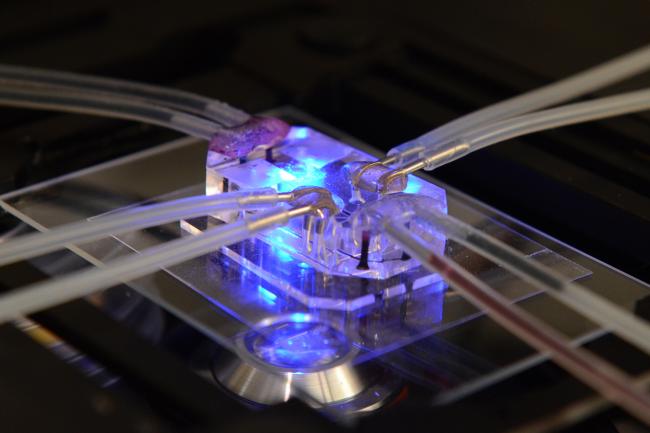Airway-on-a-chip screens drugs for use against COVID-19
May 25, 2021
Airway-on-a-chip screens drugs for use against COVID-19
At a Glance
- Researchers used an airway-on-a-chip that mimics living lung tissue to screen approved drugs for use against SARS-CoV-2.
- The most effective drug identified, called amodiaquine, is now part of a clinical trial of treatments for COVID-19.

The identification of SARS-CoV-2, the virus that causes COVID-19, in January 2020 started an international rush to find drugs that could prevent or treat infection. One potential shortcut to COVID-19 therapies is to test drugs that have already been approved for other conditions. Such repurposing of existing drugs can greatly speed the time required for human clinical trials.
To screen drugs against viruses like SARS-CoV-2, researchers often use human cell lines grown in the lab. These are easy to work with and relatively inexpensive. However, they can’t replicate the complex environment of a living organ, such as the lungs. Sometimes, drugs that work in cell lines prove ineffective—or even do harm—when later tested in people. Hydroxychloroquine is one such example.
To help overcome this challenge, a research team led by Dr. Donald Ingber from the Wyss Institute at Harvard University has been developing organ chips for more accurate screening of drugs to treat infections. These chips, which are about the size of a USB memory stick, provide an environment that can grow many cell types in close contact with each other. This allows the cells to form tissues and interfaces between tissues that mimic those found within the body.
The team grew lung tissue on an Airway Chip that included cells that line the lung airway, blood vessel cells, and even immune system cells. The tissue that grew on the chips mimicked traits seen in living lungs, such as mucus production and inflammation.
In their new study, the scientists used the Airway Chip to screen drugs for use against influenza and SARS-CoV-2. The work was funded in part by NIH’s National Center for Advancing Translational Sciences (NCATS). Results were published on May 3, 2021, in Nature Biomedical Engineering.
In proof-of-concept studies using several influenza viruses, the lung tissues in the Airway Chip showed the same types of damage after viral exposure as seen in living lungs. The drug oseltamivir, better known as Tamiflu, blocked flu virus replication in the chips over the same time period as that seen when used in people.
The team next tested drugs that were approved for other conditions for their ability to boost the effects of oseltamivir. They found that one such drug called nafamostat helped suppress infection, doubling the time window in which oseltamivir could be effectively used.
Pivoting their efforts to COVID-19, the researchers then used the chips to identify three approved drugs—amodiaquine, toremifene, and clomiphene—that could reduce SARS-CoV-2 entry into human lung cells. In contrast, hydroxychloroquine was among other drugs that, while working in cell lines, had no effect when tested in the Airway Chip. The team chose the most potent, amodiaquine, for further testing.
In hamsters, amodiaquine blocked the transmission of SARS-CoV-2 from infected to uninfected animals by 90%. When used after exposure as a treatment, the drug reduced the amount of virus in the body by about 70%. Based in part on these results, amodiaquine has been incorporated into the ongoing ANTICOV clinical trial, which is testing drugs to treat COVID-19 in 13 African countries.
“Thanks to the openness and collaboration that the pandemic has sparked within the scientific community, our lead drug is now being tested in humans,” Ingber says. “It’s a powerful testament to Organ Chips’ ability to accelerate preclinical testing.”
—by Sharon Reynolds
Related Links
- Oral Antiviral Drug Effective Against COVID-19 in Hamsters
- Nanoparticle-Based Flu Vaccine
- Immune Response to Vaccination After COVID-19
- SARS-CoV-2 Antibodies Protect from Reinfection
- Experimental Coronavirus Vaccine Highly Effective
- Final Report Confirms Remdesivir Benefits for Covid-19
- Computer-Designed Proteins May Protect Against Coronavirus
- NIH Awards $15 Million to Support Development of 3-D Human Tissue Models
- Coronavirus (COVID-19)
- Coronavirus (COVID-19) (CDC)
References
A human-airway-on-a-chip for the rapid identification of candidate antiviral therapeutics and prophylactics. Si L, Bai H, Rodas M, Cao W, Oh CY, Jiang A, Moller R, Hoagland D, Oishi K, Horiuchi S, Uhl S, Blanco-Melo D, Albrecht RA, Liu WC, Jordan T, Nilsson-Payant BE, Golynker I, Frere J, Logue J, Haupt R, McGrath M, Weston S, Zhang T, Plebani R, Soong M, Nurani A, Kim SM, Zhu DY, Benam KH, Goyal G, Gilpin SE, Prantil-Baun R, Gygi SP, Powers RK, Carlson KE, Frieman M, tenOever BR, Ingber DE. Nat Biomed Eng. 2021 May 3. doi: 10.1038/s41551-021-00718-9. Online ahead of print. PMID: 33941899.
Funding
NIH’s National Center for Advancing Translational Sciences (NCATS); Defense Advanced Research Projects Agency; Bill and Melinda Gates Foundation; Marc Haas Foundation; Wyss Institute for Biologically Inspired Engineering.


